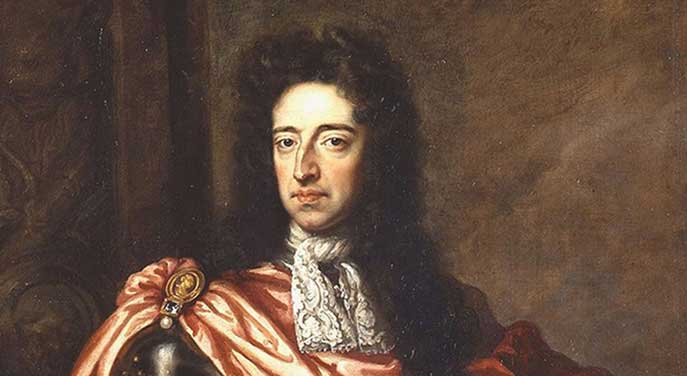 As the marching season in Northern Ireland rolls around again, William of Orange (1650-1702) comes to mind.
As the marching season in Northern Ireland rolls around again, William of Orange (1650-1702) comes to mind.
The memory of William – or King Billy – inspired the founding of the Orange Order almost a century after his death. Steadfast and stubborn in its championing of Irish Protestant identity, the Order remains committed to maintaining Northern Ireland’s position within the United Kingdom. It’ll be out in marching force this summer.
But there was much more to William than 17th century Ireland. Truth be told, Ireland was incidental to his main mission. You might even call it a sideshow in the larger struggle to resist French domination of Europe.
William’s father was Dutch and his mother was English – daughter of the beheaded Charles I. Because his father died before he was born, William succeeded to the title Prince of Orange at birth. And in an environment where religion was a defining characteristic, he was raised a Calvinist.
Thanks to marrying his first cousin – Mary Stuart – and the subsequent Glorious Revolution, William ultimately became king of England, Scotland and Ireland. However, his first loyalty was always to his Dutch homeland, which was constantly threatened by Louis XIV’s imperial France.
The Dutch weren’t alone in their fear of Louis.
The concern was sufficiently pervasive that – Calvinism notwithstanding – William was able to enlist the papacy as part of his broad anti-French alliance. And at 1690’s famous Battle of the Boyne, he fielded an impressively multinational army. Along with Irish Protestants, English and Scots, his force included Dutch, Danes, Swedes, Norwegians, Finns and Germans.
William’s historical significance as the architect of resistance to France is generally acknowledged. But his personality tends to be more elusive. Or at least less remarked on.
Apart from his lifelong affinity for Holland, just who was he?
He wasn’t a natural charmer. Words like cold, reserved and taciturn have been applied to him. Even friendly biographer Nesca Robb has described him as “ungregarious.”
Given his childhood – Robb characterizes his life as “starved of warmth” – this wasn’t entirely unexpected. William never knew his father and his mother apparently showed little interest in him, often not seeing him for long stretches. Then she died when he was 10 years old.
In an era where religious persecution was the order of the day, William was relatively tolerant. Yes, Catholics suffered restrictions. But, to quote author Michael Barone, they were still “much safer than were Protestants in the Kingdom of France.”
Health, though, was a lifelong problem.
Smallpox was prevalent – both his parents died from it – and William wasn’t spared. For several days in 1675, his situation was considered touch and go.
However, chronic asthma was the more persistent threat, on top of which he suffered from what we’d now describe as anxiety. A foreign ambassador’s 1692 report portrayed him as “of so frail a constitution that his life seems to hang by a thread.”
But other than the occasions on which he was laid low, these afflictions didn’t get in the way. He was a brave soldier and an indefatigable diplomat.
Like almost all royal marriages, William’s 1677 union with Mary was a matter of state business, not romance. By linking up with Charles II’s niece, he hoped to at least neutralize England so it wouldn’t ally with France against Holland. And there was always the prospect of it putting him into the English line of succession, which it eventually did.
Mary wasn’t pleased. Just 15 years old, she reputedly cried for hours when she heard of the impending nuptials.
William, after all, was hardly love’s young dream. Older, he was “short and unattractive, hunchbacked and hook-nosed, with a rasping cough, and a poor dresser.”
Still, the evidence suggests that they reached a reasonable accommodation and he was grief-stricken when she died – smallpox again – in 1694. Conscience might also have played a part: William had reputedly carried on a long-term relationship with Elizabeth Villiers, who’d been a lady-in-waiting to his wife.
Despite all of the above, it would be a mistake to regard William as entirely humourless. He was even prepared to enjoy a smile at the controversial Calvinist doctrine of predestination.
After his soldiers disembarked in England to launch the 1688 Glorious Revolution, he turned to the accompanying Anglican clergyman, Gilbert Burnet, and asked: “Well, Doctor, what do you think of predestination now?”
Troy Media columnist Pat Murphy casts a history buff’s eye at the goings-on in our world. Never cynical – well, perhaps a little bit. For interview requests, click here.
The views, opinions and positions expressed by columnists and contributors are the authors’ alone. They do not inherently or expressly reflect the views, opinions and/or positions of our publication.
© Troy Media
Troy Media is an editorial content provider to media outlets and its own hosted community news outlets across Canada.


